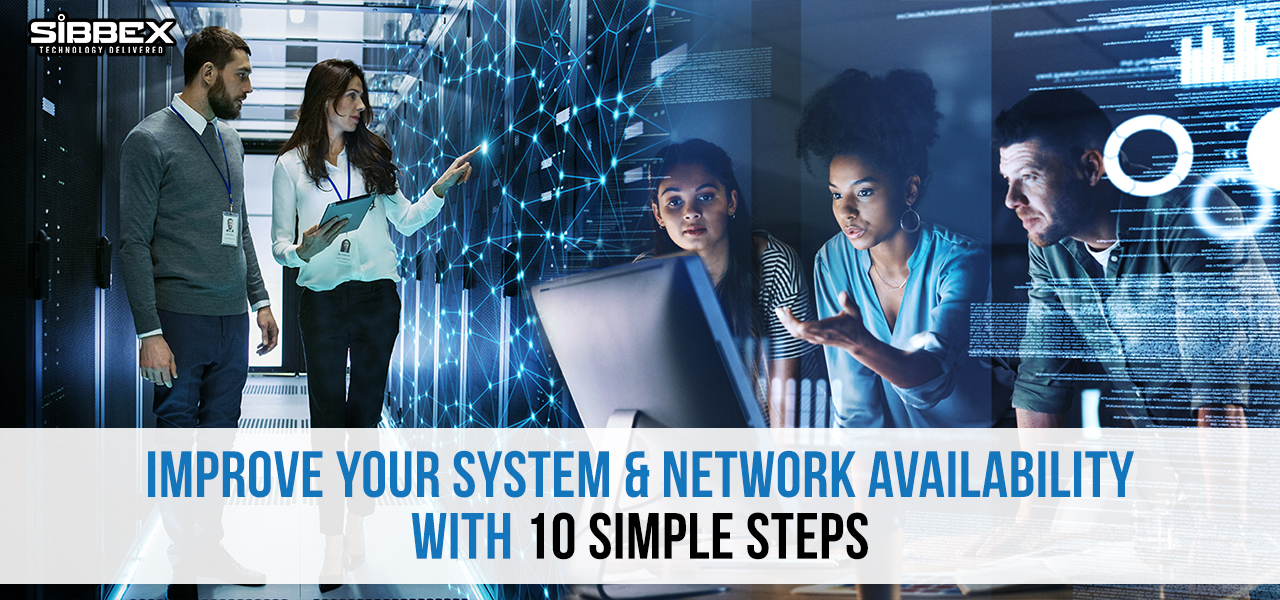Improve Your System & Network Availability With 10 Simple Steps
Network downtime is the worst type of system emergency for your company and the tech team. Not only does it halt your operations and set management on a panicked mode, but also expose the vulnerability of your system.
In today’s faced-paced work environment, you cannot afford to have a network outage or slow performance. Your business system and network appliances need to perform at the optimum level to provide a seamless user experience, gain operational efficiency and meet performance goals. As every day goes by, the dependency on IT drastically grows, and with a need to maintain the highest levels of network availability.
To achieve maximum productivity, you may be looking for result-focused methods to improve your network availability and performance for your business. Surely, applying efficient analysis and operations will allow you to discover existing performance problems and troubleshoot them respectively. But how to get there? We’re here to help!
This blog discusses all the important tips and methods you need to account for when it comes to improving your network availability and achieving peak performance. So, let’s get into it!
1. Perform a Network Audit
Is it just your network acting weirdly slow or is it the slow devices and computers? It goes without saying that you can’t suggest a cure without knowing the disease here. So, let’s make a smart move, we’d suggest you take your time before jumping to immediate conclusions. Perform a comprehensive network audit which will allow you to identify the bottlenecks, incompetent regions of your existing arrangements, and other essential variables. Chances are you’ll come across the potential bottlenecks in your network through in-depth analysis. For example, hidden loopholes, ineffective devices, and more such stuff.

2. Use Network & Device Monitoring Software
This is one of the most crucial applications to have gain better insights. Network and device monitoring tools effortlessly collect statistical information from the devices in your existing network. This allows you to have a better performance insight which you cannot achieve through the management consoles and settings apps of the individual devices. There are myriad network monitoring tools and software to choose from. Enforcing them will let you diagnose the developing problems, replace the running down of the device, and troubleshoot the errors.
3. Offer Your Guests A Separate Network
It should be noted that network slowdowns and the systems’ downtimes can also stem from guest behavior. Of course, a single guest can’t cause any problem over here – but if your company is entertaining a large number of guests daily, you can face problems. Additional guest traffic on your existing network can contribute to slowing down the operations. You can simply avoid this problem by having a separate network for your guest and providing them log in to it for accessing the internet
4. Reconfigure Your Network Hardware
Can’t put enough stress that how much it’s important to reconfigure your devices. Installing a new device into your existing network requires configuration to achieve maximum efficiency. If not configured correctly, the devices will not be able to communicate with each other, transfer data, or process important information. This will lead to increased latency, routing issues, or unprecedented downtimes. So concluding this we’d say that every time you add new hardware into a network, your tech time needs to immediately verify that changes are negatively impacting your network performance.


5. Update Software & Firmware
Got your network tied up to an old operating system and software? Well, let me tell you this, it isn’t going to work out any more as each passing day brings new advancement in technology – it’s a high time you transform your old-school methods. We’d recommend you to pick a software that is compatible with the modern technology and brings out the optimum functionality of your office equipment.
6. Use VLANs To Segment Low Priority Traffic
You can prioritize critical traffic by partitioning resources with the help of Virtual Area Local Networks (VLANs). It is an excellent way to have a completely separate network without rewiring the entire office. And the best part – you can arrange your VLANs with multiple computers and devices even if they’re present in separate parts of your office. Moreover, they also help in improving security by segmenting your systems from each other. In this way, if one part of your network faces downtime, VLAN will act as a barrier and keep other parts of your network completely safe.
7. Go For A Cloud Solution
Indeed, using Cloud infrastructure has many unparalleled benefits that can’t be found in any other technology. It has the capability to enhance your network availability and expands its operations. If you’re struggling to maintain the uptime of your network then cloud technology can ensure you a high level of uptime, up to 98%. For this reason, having a cloud solution for system management is highly recommended.


8. Educate Your Personnel About The User Behavior
It is not surprising that in some of the cases your employees might be slowly draining your network performance without even realizing it. As many employees choose to spend their free time on the system, using the bandwidth-heavy applications, booting up a heavy video, or catching up on their favorite show on Netflix. This majorly contributes to a network slowdown collectively. If such a practice continues to happen, chances are there’ll be lesser traffic available for the critical business tasks. So what’s the solution over here? Just communicate with their employees. Most will happily choose a different pastime if you inform them about the affected performance. In addition, your company should communicate to the users about the proper usage including which services and apps to avoid.
9. Have A Rehearsed Plan
When things go drastically wrong in your network, have a plan B to fall back on. If a situation resurfaces where a server goes blatantly unavailable or part of your system collapses, it’s best not to waste time and implement recovery methods immediately. For such situations, invest your time and energy in creating a well-thought-out, executable plan that is capable to return your enterprise to the previous operational health as soon as possible, without leaving major damage.


10. Reach Out To Tech Professionals
Make sure you have your professional maintenance team on your quick dial. It’s in the best practice to educate your staff about immediately contacting the tech team when an issue surfaces, so they can be reached as soon as the problem is detected and resolution is put in place before your business operations are affected.
As new trends and technology are surfacing in every realm of the business, it is high time that you incorporate smart tech solutions that drive higher network performance crucial for your business. Hope the above information will greatly help you in maximizing capability.
It’s our job to keep you well-informed about the technology trends, PC components, and tech gadgets – Stay updated with Sibbex!






